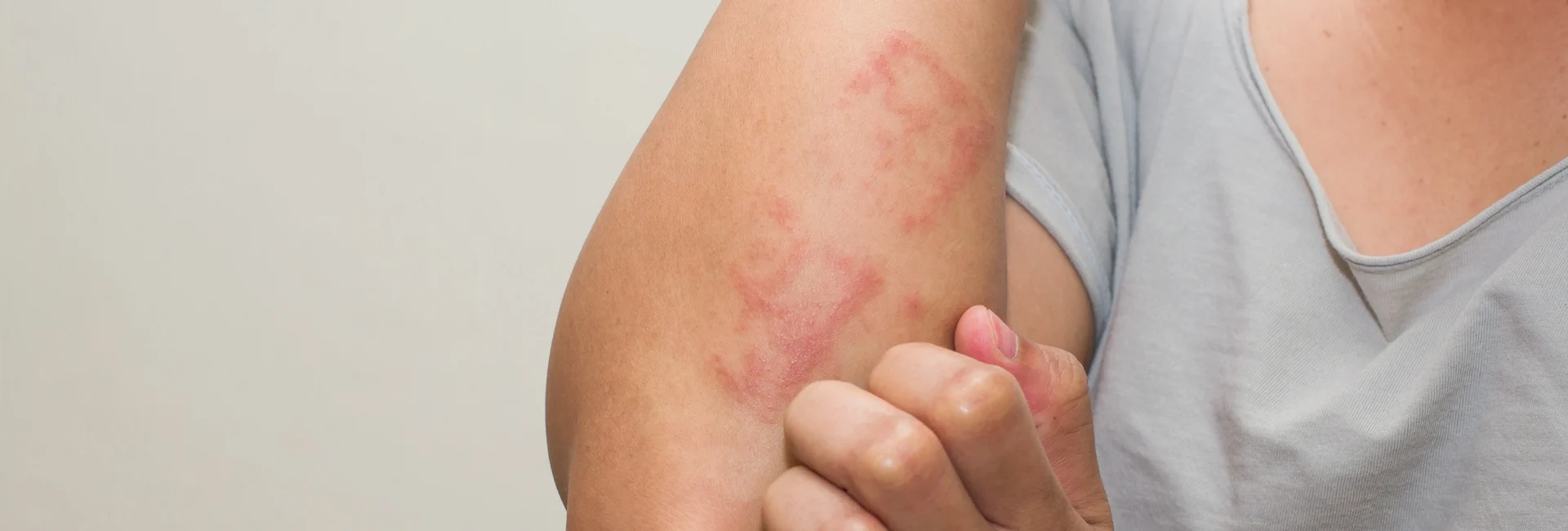Rashes are abnormal changes in the color and texture of the skin. They are often the result of skin inflammation and can cause the skin to become bumpy, scaly, itchy or red and irritated. Sometimes, rashes even appear as blotches, welts or painful blisters.
Rashes are not all alike. Some rashes are localized on a particular area of the skin, while others occur all over the body. Some rashes only last for a short time, while others are long-lasting. Some rashes are mild, while others are more serious and require medical treatment.
Read on to learn more about some of the different causes of rashes and how to help ease your itchy symptoms.
WHAT ARE SOME CAUSES OF RASHES?
Eczema/Dermatitis
Eczema/dermatitis is a rash-like skin condition that can show symptoms anywhere on the body. This skin condition can cause an individual’s skin to become red and itchy. If scratched, the skin will become inflamed and even more red. Eczema can affect both adults and children.
There are multiple types of eczema/dermatitis, including:
- Atopic dermatitis
- Irritant contact dermatitis
- Allergic contact dermatitis
- Dry skin/xerosis
- Nummular dermatitis
- Seborrheic dermatitis and dandruff
- Stasis dermatitis
- Neurodermatitis/Lichen Simplex Chronicus
Eczema/dermatitis treatment is based on the type of eczema/dermatitis that you have. Treatment options include:
- Reducing the number of times you bathe: If you shower or bathe with hot water, a dermatologist may recommend replacing it with lukewarm water, as well as using a non-foaming cleanser.
- Wearing breathable clothing: Avoid clothes that are tight, non-breathable and itchy as it can irritate the affected area.
- Protecting your skin: Replace your detergents if they are harsh on your skin.
- Using moisturizers: Apply products that aid in water loss recovery; avoid fragrant products.
- Taking prescribed medications: Depending on the severity of your eczema, your dermatologist may recommend topical steroid medications, topical anti-inflammatory medication, such as Pimecrolimus/tacrolimus cream/ointment, a non-steroidal anti-inflammatory called Crisaborole or antihistamines.
- Participating in other treatments: This could include photodynamic light therapy, oral immunosuppressive therapies and more.
Granuloma Annulare
Granuloma annulare is a chronic skin condition that consists of a circular-shaped rash made up of small, firm reddish bumps (or papules). These bumps often appear on the forearms, hands and feet. Granuloma annulare usually affects children and young adults.
Treatment for granuloma annulare is usually only necessary for cosmetic reasons. In some cases, a steroid cream or ointment is prescribed to help the rings of bumps disappear, or liquid nitrogen is used to freeze the lesions. In more severe cases, ultraviolet light therapy is used, or oral drugs are prescribed.
Lichen Planus
Lichen planus is a common skin condition that creates flat, shiny-topped bumps. The bumps are reddish-purple and are angular in shape. They frequently appear on the insides of the wrists and ankles, lower legs and back and neck. Sometimes, they also appear inside the mouth or on the scalp. Lichen planus typically affects adults between the ages of 30-70.
Though lichen planus is incurable, its symptoms can be treated with anti-itch medications like antihistamines. In more serious cases, light therapy is used, or steroid shots, prednisone, or other immunosuppressive medications are prescribed.
Pityriasis Rosea
Pityriasis rosea is a mild skin rash that begins with a large, scaly pink area of skin located on the back or chest. Additional pink areas of skin also form and become red, itchy or inflamed. This rash differs from person to person and often affects the back, chest, neck, upper abdomen and legs.
Mild cases of pityriasis rosea typically go away on their own. Oral antihistamines and prescription steroids are often prescribed to help soothe symptoms like itching. Ultraviolet light is also used to help heal sores caused by pityriasis rosea.
Other Types of Rashes
Besides what is listed above, there are other causes for rashes to be mindful of, including:
- Pityriasis rosea
- Heat rash
- Intertrigo
- Diaper rash
- Psoriasis
- Ringworm
- Chickenpox
- Shingles
- Rosacea
- Systemic lupus erythematosus
- Fifth disease
- Hand foot and mouth disease
- Cellulitis
- Drug allergies
- Scabies
- Measles
- Scarlet fever
CAN YOU PREVENT RASHES?
Not every rash is preventable. In some cases, rashes are the result of certain diseases. Specific genes can even cause people to get rashes more than others. Since there are so many different causes of rashes, you must visit your dermatologist for diagnosis and treatment.
Dermatologists recommend the following tips to prevent itching:
- Bathe with lukewarm water
- Always use “fragrance-free” lotions, soaps and detergents
- Apply medications before moisturizing
- Wear loose-fitting, cotton clothes
- Avoid extreme temperature changes
- Reduce stress
And whatever kind of rash you have, do not scratch it! Scratching only causes the skin to open up and bleed, which raises the risk of infection.
WHEN SHOULD YOU SEEK IMMEDIATE MEDICAL TREATMENT?
Most rashes are not life-threatening, but sometimes, rashes can be a signal that something serious is wrong. If you notice any of these symptoms, contact your dermatologist or visit the emergency room immediately:
- The rash is all over your body
- You have a fever with the rash
- The rash is sudden and spreads rapidly
- The rash begins to blister
- The rash is painful
- The rash is infected
VISIT YOUR DERMATOLOGIST | THE DERMATOLOGY CENTER FOR SKIN HEALTH, PLLC
Rashes can be frustrating conditions to deal with. At the Dermatology Center for Skin Health, PLLC, we want to do whatever we can to help diagnose and treat your rash. If you would like to learn more about what is causing your rash and learn how to treat or manage your symptoms, give us a call at (304) 598-3888 or click here. We are currently accepting new patients and encourage you to make your appointment soon. We look forward to hearing from you!
References:
Rash: 22 Common Skin Rashes, Pictures, Causes, and Treatment


